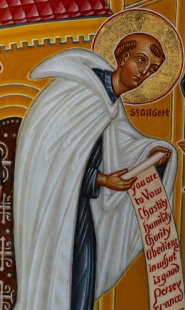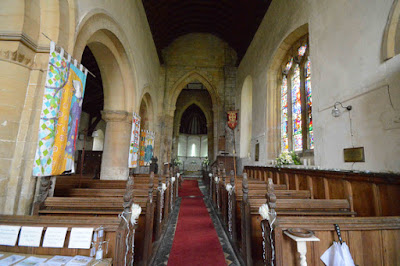The study of the order of
St Gilbert, which is of English origin, shows how in this country also sympathy
with convent life was spreading during the 12th century, and how, owing to the
protection afforded to peaceful and domestic pursuits by the religious houses
many girls and women of the middle classes became nuns. From an intellectual
point of view the order of St Gilbert has little to recommend it, for we know
of no men or women belonging to the order who distinguished themselves in
learning, literature or art. As a previous chapter has indicated, its purpose
was chiefly to prevent women from drifting into the unattached and homeless
class, the existence of which was beginning to be recognized as prejudicial to
society.
The material for the study
of the order is abundant. We have several accounts of the life and work of
Gilbert, besides minute injunctions he drafted to regulate the life of his
communities, and there are references to him in contemporary literature. The
success of his efforts, like that of the men who founded combined orders of
canons and nuns abroad, was due to the admission of women into his settlements
regardless of their class and antecedents. Like Robert of Arbrissel his
interest centered in women, but he differed from him in giving the supreme
authority of his settlements into the hands of men. For the settlements which
afterwards became double originated in Gilbert's wish to provide for women who sought him as their spiritual
adviser. It was only in consequence of the difficulties he encountered that
canons were added to the settlements.
Helyot likens the order of
St Gilbert to that of Norbert, the founder of the order of Prémontré,[2*]
but here too there are marked points of difference, for in disposition and
character Gilbert was as unlike Norbert as he was to Robert; he had neither the
masterfulness of the one nor the clear-sighted determination of the other. The
reason of his popularity lies more in his gentleness and persuasiveness, and
these qualities made him especially attractive to women.
Gilbert was a native of
Lincolnshire, born about 1083, the son of a wealthy Norman baron and an English
woman of low rank. His ungainly appearance and want of courtly bearing rendered
him unfit for knightly service. He was sent to France for his education and
there attained some reputation as a teacher. After his return home he devoted
his energies to teaching boys and girls in the neighborhood. His father
bestowed on him two livings, one of which was at Sempringham. His chief
characteristic was pity for the lowly and humble, and this attracted the
attention among others of Robert Bloet, bishop of Lincoln († 1123). For a time
Gilbert acted as a clerk in Bloet's house, and after his death remained with
his successor Alexander († 1148) in a like capacity. With Alexander he consulted
about permanently providing for those of the lower classes whom his liberality
was attracting to Sempringham.
The first step taken by
Gilbert was to erect suitable dwellings round the church of St. Andrew at
Sempringham for seven women whom he had taught and who had devoted themselves
to religion under his guidance, and as they were not to leave their dwelling
place, lay sisters were appointed to wait on them. He also provided dwellings
at Sempringham for the poor, the infirm, for lepers, and orphans.
The order of Gilbert is
held to have been established before 1135, the year of King Henry l's death.[3*]
The author of his life in Dugdale likens Gilbert's progress at this time to the
chariot of Aminadab; to it clung clerics and laymen, literate and illiterate
women, and it was drawn by Master Gilbert himself.
Gilbert had entered into
friendly relations with the Cistercian monks who were then gaining ground in Yorkshire, and
William, first abbot of Rievaulx († 1145--6), was among them. He had a good
deal to do with Aelred († 1166), a notable north-country man who came from
Scotland to live at Rievaulx, and afterwards became abbot successively of
Revesby and Rievaulx.
At this time there were no
nunneries in the north of England, for the great settlements of the early
English period had passed away and no new houses for women had been founded.
The numbers of those who flocked to Gilbert were so great that he felt called
upon to give them a more definite organization. His friendship with Cistercian
monks no doubt turned his eyes to Citeaux, and the wish arose in him to
affiliate his convents to the Cistercian order. Having placed his congregations
under the care of the Cistercians, he set out for Citeaux about 1146.
But his hopes were not
fulfilled. At Citeaux he met Pope Eugenius III († 1153) and other leading men.
He cemented his friendship with Bernard of Clairvaux and entered into friendly
relations with Malachy, bishop of Armagh († 1 148), who had introduced the
Cistercian order into Ireland. But the assembly at Citeaux came to the
conclusion that they would not preside over another religious order, especially
not over one for women,[4*]
and Gilbert was urged to remain at the head of his communities and Bernard and
Malachy presented him with an abbot's staff.
He returned to England,
burdened with a responsibility from which he would gladly have been free, and
obliged to frame a definite rule of life for his followers. As one account puts
it, 'he now studied the rules of all religious orders and culled from each its
flowers.' The outcome of his efforts was the elaborate set of injunctions which
now lie before us.
From these injunctions we
can see how Gilbert's original plan had expanded, for his settlements consisted
of bands of canons, lay-brethren, nuns, and lay-sisters. One set of rules is
drafted for the canons that observed the rule of St Augustine and performed
religious service for the double community, and a separate set for the laymen
who acted as servants. And similarly there is one set of rules for the nuns who
lived by the rule of St Benedict and another for their servants the
lay-sisters.
These rules suggest many
points of similarity to the combined settlements of canons and nuns previously
founded abroad, but there are also some differences.
In the Gilbertine
settlements the dwellings of the men and women were contiguous, and the convent
precincts and the church were divided between them. The men's dwelling was
under the rule of a prior, but three prioresses ruled conjointly in the women's
house. The arrangements in both convents were alike, and the duties of prior
and prioress similar, but in all matters of importance the chief authority
belonged to the prior who was at the head of the whole settlement. The property
owned by Gilbertine settlements apparently consisted largely of sheep and among
the men we note a number of shepherds and a 'procurator' who bought and sold
the animals. The ewes were regularly milked and the wool was either used in the
house for making clothes, or sold. The lay-sisters were appointed to spin and
weave and the nuns to cut out and make the garments.
There was one cellar and
one kitchen for the whole settlement, for the cellaress in the women's house
acted as caterer both for the canons and the nuns. Domestic duties fell to the
share of the women. They cooked the canons' food as well as their own and
handed the meals into the men's quarters through a hole in the wall with a
turn-table, through which the plates and dishes were returned to them. They
also made clothes for the whole establishment.
At the daily chapter held
in the women's house the prioresses presided in turn, with a companion on
either side. The cellaress reported to the prioress, which settled the
allowances and gave out the food. She received information also from the
'scrutatrices,' the nuns whose duty it was to go the round of the house and
report disorders, and according to whose reports she imposed the various
penances.
We also hear in the women's
house of a librarian ('precentrix'[5*]
), who had the keys of the book-case ('armarium'), which was kept locked except
during reading time when the nuns were allowed the use of the books. There was
to be no quarrelling over the books; the nun like the canon was directed to
take the one allotted to her and not to appropriate that given to another.
Simplicity of life was studied. Pictures and sculpture were declared
superfluous and the crosses used were to be of painted wood. Only books for
choir use were to be written in the convent, but while this holds good alike
for the women and for the men, there is this further prohibition with regard to
the nuns, that talking in Latin was to be avoided. 'Altogether,' says the rule,[6*]
'we forbid the use of the Latin tongue unless under special circumstances.
The cooking was done by the
nuns in turn for a week at a time in compliance with a regulation contained in
the rule of St Benedict. The librarian also had her week of cooking, and when
she was on duty in the kitchen, gave up her keys to another nun. We hear also
of the mistress appointed to teach the novices, and of the portress who guarded
the approaches to the house.
The injunctions drafted for
the canons and the lay members of the settlement are equally explicit.
Directions are also given about tending the sick, who were to be treated with
tenderness and care.
Girls were admitted into
the company of the nuns at the age of twelve, but several years passed before
they could be enrolled among the novices. At the age of twenty the alternative
was put before the novice of joining the nuns or the lay-sisters. If she
decided in favour of the latter she could not afterwards be promoted to the
rank of nun; she was bound to observe chastity and obedience while she remained
in the house, but she was not consecrated. A certain amount of knowledge of the
hymns, psalms and books of service was required from the novice before she
could make profession.
The scheme of life worked
out by Gilbert met with success and numerous patrons were found to endow
settlements on the plan of that at Sempringham. As the chronicler says, 'many
wealthy and highborn Englishmen, counts and barons, seeing and approving of the
undertaking the Lord had initiated and holding that good would come of it,
bestowed many properties (" fundos et praedia') on the holy father
(Gilbert) and began to construct on their own account numerous monasteries in
various districts.'
The greater numbers of
these settlements were situated in Lincolnshire and Yorkshire, but judging by
the extant charters the conditions and purposes of their foundations were not
always the same. Sometimes the grant is made conjointly to men and women;
sometimes reference is made to the prior only. In the earlier charters the
women are especially noticed, in the later ones more account is taken of the
men. As time went on the order gradually ceased to have any attraction for
women, and at the time of the dissolution several foundations originally made
for men and women were occupied only by canons.
Gilbert himself did not
accept a position of authority in his order but became a canon at Bullington,
one of its settlements. He appears to have been influential in wider circles
and we find him several times at court. King Henry II visited him, and both the
king and Queen Eleanor made grants of land to the order. Henry regarded Gilbert
with so much favour that when he was summoned before the King's Court in London
on the charge of having supported Becket in his exile, the king sent a message
from abroad ordering his case to be. Reserved for royal judgment, which
practically meant his acquittal.[7*]
Rapidly as the number of
Gilbertine houses increased, the order did not remain entirely free from
trouble, for even in Gilbert's lifetime distressing incidents happened which
justified to some extent the scornful remarks of contemporary writers. One of
these difficulties arose sometime between 1153 and 1166 in connection with a
girl at Watton. A full account of the affair was written and forwarded to
Gilbert by Aelred, abbot of Rievaulx.[8*]
This account illustrates pointedly the readiness of the age to accept a
miraculous rendering of fact, and gives a curious insight into the temper of a
community of nuns. Indeed such violence of conduct and details of such behavior
as are here described show that the barbarity of the age, which so often
strikes us in connection with camp and court, was reflected in the monastery.
Watton was among the older
Gilbertine houses and had been founded before 1148 by a nobleman Eustace Fitz-John
on property which had belonged to a nunnery during the early English period.[9*]
The settlement was among the larger Gilbertine houses; it owned property to the
extent of twenty acres.
The girl had been placed
under the care of the nuns of Watton at the suggestion of Murdach, abbot of
Fountains († 1153), and had given endless trouble by her unbecoming levity and
hopeless laziness. 'She is corrected by word of mouth but without result, she
is urged by blows but there is no improvement,' writes Aelred, who speaks of
her as a nun without telling us that she had actually made profession.
She made the acquaintance
of one of the lay-brothers who were engaged in repairing the women's dwelling.
The two contrived to meet
frequently out of doors until at last the nun's condition became obvious. Her
fellow-nuns were so incensed at this discovery that they treated her with
barbarous cruelty and would have put her to death had not the prioress
intervened and had her chained and imprisoned. The anger of the nuns now turned
against the lay-brother who had brought disgrace on their convent, and with a
mixture of cunning and deceit they managed to discover him and have him
terribly mutilated. 'I do not praise the deed, but the zeal,' says Aelred; 'I
do not approve of bloodshed, but for all that I praise the virgins' hatred of
such wickedness.' The esprit de corps among the nuns and their indignation
evidently went far in his eyes to excuse behavior which he would not describe
as he did if he had not felt it altogether reprehensible.
Meanwhile the nun overcome
by contrition was awaiting her delivery in prison; there she had visions of
abbot Murdach who had died some years before. He first rebuked her, but then
miraculously relieved her of her burden and restored her to her normal
condition. The nuns though greatly surprised were convinced of the truth of the
statement concerning the miraculous doings of Murdach because they found the
nun's chains loosened. The prior of Watton sent for Ailred to enquire more
closely into the matter. Aelred came, collected all possible evidence, and was
convinced that there had been divine intervention on the girl's behalf. He
wrote an account of what had happened to Gilbert, with these words as preface:
'to know of the Lord's miracles and of his proofs of divine love and to be
silent about them were sacrilege.' What became of the girl we are not told. For
trespasses such as hers the rule of Gilbert decreed life-long incarceration,
but the canon for a like trespass suffered no punishment beyond being expelled
from the settlement.
The old age of Gilbert was
further troubled by the evil conduct of two men, Gerard a smith, and Ogger a
carpenter. He had taken them into the order out of charity, but they greatly
abused his kindness, appropriated the revenues of the order, and encouraged
dishonesty and sexual irregularities. Their behavior was productive of such
results that it called forth a letter from Becket to Gilbert in which he says
'the greater our love, the more we are troubled and perturbed by hearing of
things happening in your order, which are a grievance not only before the eyes
of men but before the eyes of God.'
However letters in defense
of Gilbert were written by Roger archbishop
of York († 1181), Henry bishop of Winchester († 1171) and William bishop of
Norwich († 1174), who treat the occurrence as a misfortune and praise the order
generally in the warmest terms. Praise from other quarters is not wanting,
which shows that Gilbert's work was considered remarkable, especially with
regard to the influence he had over women. William of Newburgh wrote of him:
'As far as this is concerned, in my opinion he holds the palm above all others
whom we know to have devoted their energies to the control and government of
religious women.[10*]
Gilbert lived to an
advanced age. Walter Map, writing between 1182 and 1189, speaks of him as over
a hundred and well-nigh blind. He was buried at Sempringham, where his tomb
became the goal of many pilgrimages and the scene of many miracles. He was canonized
a saint of the Church by Pope Innocent II in 1202. One of the accounts of his
life, written shortly after his death, says that the order at that time
numbered thirteen conventual churches and contained seven hundred men and
fifteen hundred women.
The East Riding Antiquarian
Society has recently begun excavating on the site of Watton Priory, one of the
oldest Gilbertine settlements, and has ascertained many particulars about the
inner arrangements of this house.[11*]
It has found that the church, built on the foundations of a Norman church which
had been destroyed by fire in 1167, was divided throughout its entire length by
a substantial partition wall nearly five feet thick. The church served for both
sexes of the community, which were kept separate by this partition. In some
places remains of this wall were found up to the height of four feet; this was
part of the solid foundation upon which, above the height of the eye, was
erected an open arcade which made it possible for the whole community to hear
the sermon preached on festal days from the pulpit. The parts into which the
church was divided were of unequal size. Dr Cox, the president of the Society,
who read a paper on the Gilbertine statutes, said that the full complement of
the double house at Watton consisted of a hundred and forty women and seventy
men, and that the larger part of the church was appropriated to the women and
the smaller to the men.
It was further shown by the
excavations that the dividing wall had in one place an archway, covering the
door which was opened for the great processions of both sexes which took place
on the fourteen great
festivals of the year and at funerals. Remains were also found of an opening in
the wall with a turn-table, so arranged that articles could be passed through
without either sex seeing the other. Through this the chalice, when the canons'
mass was over, would be passed back and restored to the custody of the nuns; no
doubt this was constructed on the same plan as the opening through which the
food was passed.
The cloister of the nuns
lay on the north side of the transept and must have been about a hundred feet
square, an alley of ten feet wide surrounding it. It is thought that the stone
of which the house was built must have been brought up the Humber from Whitby.
An early writer tells us that the nuns' dwelling at Watton was connected by an
underground passage with the holy well at Kilnwick, and that the nuns by means
of these waters performed wonderful cures.[12*]
Notes
[1*] A. SS. Boll., St
Gilbert, Feb. 4, contain two short lives; Dugdale, Monasticon, vol. 6
inserted between pp. 946, 947, contains a longer account, the 'Institutiones,'
and various references to Gilbert; Dict. of Nat. Biography refers to a
MS. account at Oxford, Digby, 36, Bodleian.
[2*] Helyot, Histoire des
ordres mmon., 1714, vol. 2, p. 190.
[3*] Dict. Of Nat.
Biography.
[4*] A. SS. Boll., St
Gilbert, Feb. 4 , Vita, nr 2, ch. 3; Dugdale, Vita, p. xi.
[5*] The 'precentrix' is
strictly speaking the leader of the choir. Cf. Below ch. 10. 2.
[6*] Dugdale, Institutiones,
p. 1xxxii.
[7*] Dic. of Nat Biography.
[8*] Ailred, Opera (in
Migne, Patrol. Cursus comp., vol. 195), p. 789. 'De sanctimoniali de
Wattun.'
[9*] Oliver, G., History of
Beverley and Watton, 1829, p. 520 ff.; cf. above, p. 91.
[10*] Dugdale, Monasticon,
vol. 6, p. xcviii.
[11*] Report in Athenaeum,
Oct 7, 1893.
[12*] Oliver, G., History of
Beverley and Watton, 1829, p. 531.





















